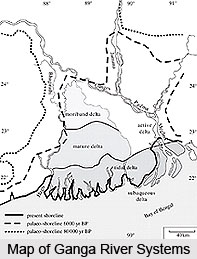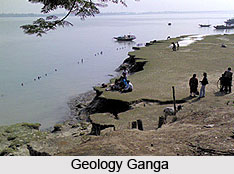 The perennial river Ganga takes birth in the great Himalayas and flows through the Northern Plains of India and empties into the Bay of Bengal. The rich alluvial deposits carried by the river over a vast period of time have shaped the Northern plains of India. The Ganga is associated with the legend of the sacrament carried out by King Bhagiratha to bring the heavenly river down to the earth. The Ganga has its source in the Gangotri glacier amidst the lofty Himalayas at a height of about 14000 feet above sea level. Bindu -Sar is near Gangotri and is referred to as the place where Bhagiratha is believed to have washed out his repentance of sins.
The perennial river Ganga takes birth in the great Himalayas and flows through the Northern Plains of India and empties into the Bay of Bengal. The rich alluvial deposits carried by the river over a vast period of time have shaped the Northern plains of India. The Ganga is associated with the legend of the sacrament carried out by King Bhagiratha to bring the heavenly river down to the earth. The Ganga has its source in the Gangotri glacier amidst the lofty Himalayas at a height of about 14000 feet above sea level. Bindu -Sar is near Gangotri and is referred to as the place where Bhagiratha is believed to have washed out his repentance of sins.
Late Quaternary sediments of the Bengal basin owe its richness to the river Ganges. The river has its history of river switching, climate change as understood from sand- and clay-size mineralogy of boreholes, and modern riverbed grabs. The epidotes to garnet ratios or E/G in sand fraction sediments of the River Ganga are diagnostic of source, with high E/G and thus indicating Brahmaputra provenance and low E/G indicating Ganges provenance. In the clay fraction of surface sediments of the river basin is diagnostic, with high values in the Ganges and low values in the Brahmaputra. In contrast, the Brahmaputra contains more kaolinite, more illite and more chlorite than the Ganges.
Examination of mineralogic and stratigraphic data shows that the two rivers have changed position several times during the Holocene. Comprehensive periods of mixed river inputs appear to be isolated to the Early Holocene, suggesting rapidly migrating braided channels at the sea level area.
 The abundance of illite, chlorite, smectite and kaolinite has recorded the varied degrees of physical and chemical weathering in the Ganges basin. In early post-glacial deposits, it is clearly visible that dominance of physical weathering was prevalent at that time. However, a common increase in SK concentrations throughout the Gangetic basin appears to reflect improved chemical weathering under increasingly warmer and damper conditions. The weathering patterns in the catchment area respond quickly to climatic shifts.
The abundance of illite, chlorite, smectite and kaolinite has recorded the varied degrees of physical and chemical weathering in the Ganges basin. In early post-glacial deposits, it is clearly visible that dominance of physical weathering was prevalent at that time. However, a common increase in SK concentrations throughout the Gangetic basin appears to reflect improved chemical weathering under increasingly warmer and damper conditions. The weathering patterns in the catchment area respond quickly to climatic shifts.
At its origin, the river Ganges is referred to as Bhagirati. The Jahnavi and the Alakananda merge with the Ganga in the Himalayas. On the banks of the Alakananda is the ancient Himalayan pilgrimage town of Badrinath. While moving down through Rishikesh, the river descend down to the fertile plains at Haridwar, this place is also referred to as Gangadwara.
The Ganga then flows through the Indian state of Uttar Pradesh and Bihar and many towns of ancient pilgrimage like Benares and Prayag are sited along this river. Prayag or Triveni Sangamam marks the merging of the river Yamuna with the Ganga. About 250 miles before reaching the ocean, the river divides itself into several streams, and empties into the Bay of Bengal. The Ganga here is known as the Brahmaputra. The Ganga is also known by other names such as the Padma and the Meghna. One of the islands at the mouth of the river Ganga is the Gangasagar. This place is said to be the location of the hermitage of Kapila Muni, who is associated with the legend of Bhagiratha and the descent of the river Ganga.















